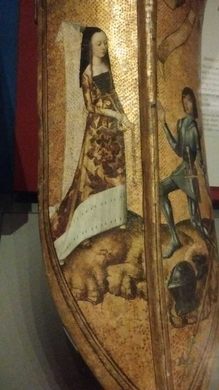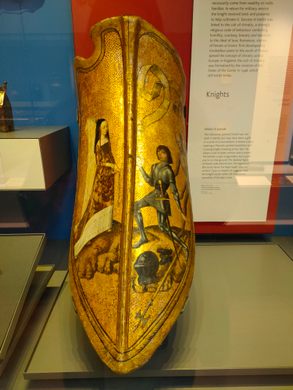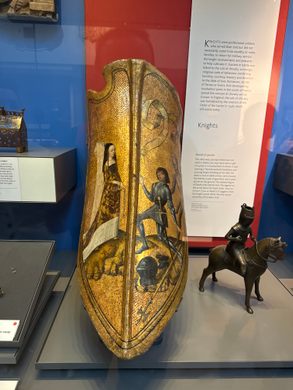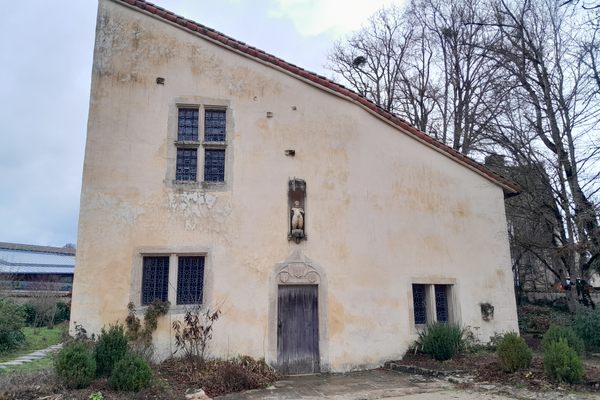Shield of Parade
This magnificently macabre shield shows the power of chivalrous love in medieval times.
While wandering through the medieval gallery of the British Museum, a gold-painted shield may catch your eye with its dazzling color that seems undiminished by its age. But if you take a closer look, peering through the glass exhibit case to examine it further, you are likely to be shocked by its sinister symbolism.
The image painted on the front of the shield shows on one side a young knight in Italian-style battle armor kneeling on the ground. He carries a pole axe in one hand and a sword is sheathed at his side while his helmet and gauntlets lie on the ground nearby. Behind the knight looms a sinister cadaver representing death. This macabre entity leers with evil intent and appears to have taken hold of the knight, wrenching him backward.
On the other side of the shield stands a rather arrogant-looking noble lady dressed in her gilded finery, wearing a long hennin hat with a trailing silk veil blowing in the breeze. The facial expression of this maiden suggests an attitude strangely removed and distant from the shocking scene unfolding in front of her, as if unaware of what is happening.
A flowing scroll floats above the scene inscribed with the words “vous ou la mort,” which translates as “you or death” from French. These words reveal that this scene is one of chivalrous love, from a knight who would rather die than dishonor his lady and lose her love for him by faltering in battle. Seemingly, the knight is about to honor this pledge and be dragged off by the cadaverous figure of death.
As the name suggests, this shield was never intended for use on the battlefield and instead would be carried ornamentally by knights in processions. It is believed to have been created in either Burgundian France or Flanders sometime around the 1470s. Objects such as this would be used specifically in parades that celebrated victory in the aftermath of battles. Such events were meant to dazzle and impress the attending public through a visual spectacle that glorified the triumph and bravery of the victors.
Although this artifact no longer inspires the same feeling of admiration in the modern viewer as it did to those in the medieval era, the imagery of the Shield of Parade still wields a power to fascinate visitors to the British Museum centuries after its creation.
Know Before You Go
The Shield of Parade can be found in the medieval galleries of the British Museum in room 40 ("Medieval Europe 1050-1500") where the Lewis chessmen are also located. The British Museum is open daily from 10 a.m. to 5:30 p.m. and from 10 a.m. to 8:30 p.m. on Fridays. Entrance is free.

























Follow us on Twitter to get the latest on the world's hidden wonders.
Like us on Facebook to get the latest on the world's hidden wonders.
Follow us on Twitter Like us on Facebook